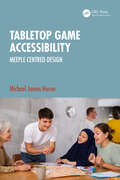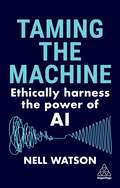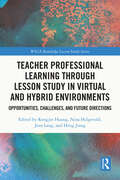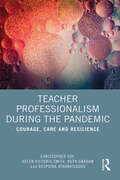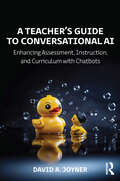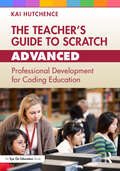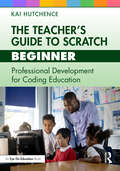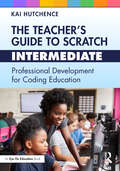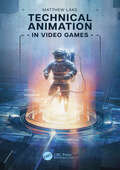- Table View
- List View
Systems Science for Engineers and Scholars
by Avner EngelSystems Science for Engineers and Scholars Brings a powerful toolkit to bear on engineering and scientific endeavors. This book describes the fundamental principles of systems science so engineers and other scholars can put them into practical use at work and in their personal lives. Systems science aims to determine systemic similarities among different disciplines and to develop applicable solutions in many fields of inquiry. Systems Science for Engineers and Scholars readers will discover: Ten systems science principles that open engineers’ and scholars’ horizons to practical insights related to their areas of interest A methodology for designing holistic systems that exhibit resilient behavior to overcome systems’ context uncertainties The most critical current dilemma of humankind—the global environment and energy crises, as well as a systemic, no-nonsense action plan to deal with these issues Independent articles describing how engineers and scholars can utilize systems science creatively in (1) engineering and systemic psychology; (2) delivering value and resolving conflicts; (3) multi-objective, multi-agent decision-making; (4) systems engineering using category theory; (5) holistic risk management using systems of systems failures methodology; and (6) systemic accident and mishap analysis Systems Science for Engineers and Scholars contains a broad spectrum of insights as well as an extensive set of examples and graphics that make it ideal for professionals and students interested in a holistic, systems-oriented approach.
Systems, Smart Technologies and Innovation for Society: Proceedings of CITIS’2023, Volume 2 (Lecture Notes in Networks and Systems #871)
by Juan Pablo Salgado-Guerrero Hector Rene Vega-Carrillo Gonzalo García-Fernández Vladimir Robles-BykbaevThis book is dedicated to exploring the practical applications and future perspectives of intelligent technologies. It delves into various domains, including industry, mobility, telecommunications, and environmental considerations. The innovative nature of this text enables us to draw connections between technical advancements and experiences aimed at enhancing the integration of emerging technologies on local, national, and regional scales. It showcases the strides made in diverse engineering domains, underlining the book’s multidisciplinary appeal. This book is intended for a wide readership, catering to master's and doctoral students, professors, and researchers in the field of cutting-edge technologies. It also extends its relevance to businesses engaged in engineering development. The contents offer insights into novel methodologies, real-world case studies, and innovative techniques designed to optimize systems, ultimately contributing to societal progress.
Systems, Smart Technologies and Innovation for Society: Proceedings of CITIS´2023, Volume 1 (Lecture Notes in Networks and Systems #870)
by Juan Pablo Salgado-Guerrero Hector Rene Vega-Carrillo Gonzalo García-Fernández Vladimir Robles-BykbaevThis book is dedicated to exploring the practical applications and future perspectives of intelligent technologies. It delves into various domains, including industry, mobility, telecommunications, and environmental considerations.The innovative nature of this text enables us to draw connections between technical advancements and experiences aimed at enhancing the integration of emerging technologies on local, national, and regional scales. It showcases the strides made in diverse engineering domains, underlining the book’s multidisciplinary appeal. This book is intended for a wide readership, catering to master's and doctoral students, professors, and researchers in the field of cutting-edge technologies. It also extends its relevance to businesses engaged in engineering development. The contents offer insights into novel methodologies, real-world case studies, and innovative techniques designed to optimize systems, ultimately contributing to societal progress.
Tabletop Game Accessibility: Meeple Centred Design
by Michael James HeronThis foundational resource on the topic of tabletop game accessibility provides actionable guidelines on how to make games accessible for people with disabilities. This book contextualises this practical guidance within a philosophical framework of how the relatively abled can ethically address accessibility issues within game design.This book helps readers to build understanding and empathy across the various categories of accessibility. Chapters on each category introduce ‘the science’, outline the game mechanics and games that show exemplar problems, relate these to the real-world situations that every player may encounter, and then discuss how to create maximally accessible games with reference to the accessibility guidelines and specific games that show ‘best-in-class’ examples of solutions.This book will be of great interest to all professional tabletop and board game designers as well as digital game designers and designers of other physical products.
Tabletop Game Accessibility: Meeple Centred Design
by Michael James HeronThis foundational resource on the topic of tabletop game accessibility provides actionable guidelines on how to make games accessible for people with disabilities. This book contextualises this practical guidance within a philosophical framework of how the relatively abled can ethically address accessibility issues within game design.This book helps readers to build understanding and empathy across the various categories of accessibility. Chapters on each category introduce ‘the science’, outline the game mechanics and games that show exemplar problems, relate these to the real-world situations that every player may encounter, and then discuss how to create maximally accessible games with reference to the accessibility guidelines and specific games that show ‘best-in-class’ examples of solutions.This book will be of great interest to all professional tabletop and board game designers as well as digital game designers and designers of other physical products.
Taming the Infinities of Concurrency: Essays Dedicated to Javier Esparza on the Occasion of His 60th Birthday (Lecture Notes in Computer Science #14660)
by Stefan Kiefer Jan Křetínský Antonín KučeraJavier Esparza received his primary degree in Theoretical Physics and in 1990 his PhD in Computer Science from the University of Zaragoza. After positions at the University of Hildesheim, the University of Edinburgh, and the Technical University of Munich, he then held professorships at the University of Edinburgh and the University of Stuttgart, and finally returned to TU Munich where he currently holds the Chair of Foundations of Software Reliability and Theoretical Computer Science. Javier is a leading researcher in concurrency theory, distributed and probabilistic systems, Petri nets, analysis of infinite-state models, and more generally formal methods for the verification of computer systems. He has coauthored over 200 publications, many of them highly influential. He coauthored the monographs Free Choice Petri Nets, and Unfoldings: A Partial Order Approach to Model Checking, and more recently the textbook Automata Theory: An Algorithmic Approach. The latter is an exampleof Javier’s many activities as a teacher, he has supervised more than 20 PhD students, taught at more than 20 summer schools, and won many awards for his university teaching. He is regularly invited to deliver plenary talks at prestigious computer science conferences and participate in senior program committees, he has contributed as a senior member of technical working groups, society councils, and journal editorial boards, and in 2021 he became a founding Editor-in-Chief of the open-access TheoretiCS journal. This Festschrift celebrates Javier’s contributions on the occasion of his 60th birthday, the contributions reflect the breadth and depth of his successes in Petri nets, concurrency in general, distributed and probabilistic systems, games, formal languages, logic, program analysis, verification, and synthesis.
Taming the Machine: Ethically Harness the Power of AI
by Nell WatsonAI promises to transform our world, supercharging productivity and driving new innovations. Taming the Machine uncovers how you can responsibly harness the power of AI with confidence.AI has the potential to become a personal assistant, a creative partner, an editor and a research tool all at once. But it also represents a threat to your livelihood, data and privacy. Taming the Machine offers the practical insights and knowledge you need to work with AI with an ethical and responsible approach.In this book, celebrated AI expert and ethicist Nell Watson offers practical insights on how you can ethically innovate with AI. It delves into the ethical issues of unbridled AI, highlighting the challenges that it will bring to society and business unless we fortify cybersecurity, safeguard our data, and understand the dangerous potential of artificial intelligence.Step into the future and supercharge your performance safely by Taming the Machine.
TCP, UDP und QUIC Internals: Protokolle und Programmierung
by Peter MandlDas Lehrbuch vermittelt praxisbezogen wichtige Grundkonzepte der Datenkommunikation mit einem Fokus auf den wichtigsten Transportprotokollen des Internets und auf der Entwicklung verteilter Anwendungen. Besonders ausführlich betrachtet der Autor die Transportprotokolle TCP und UDP, aber auch das neue, ursprünglich von Google für die Webkommunikation mit HTTP/3 entwickelte und inzwischen standardisierte Protokoll QUIC wird in der 2. Auflage ausführlich und verständlich erläutert. Dabei werden auch die zugrundeliegenden Kommunikationskonzepte anschaulich beschrieben. Um die Vorteile von QUIC im Vergleich zu TCP zu verstehen, werden auch die Grundlagen des Transport Layer Security (TLS) Protokolls, das in QUIC nun bereits integriert ist, in der vorliegenden 2. Auflage eingeführt. Die Nutzung von Transportmechanismen in der Programmierung eigener Kommunikationsanwendungen über die Socket API wird ebenfalls mit vielen Beispielen vor allem in Java, aber auch grundlegend in C erläutert. Neben den wesentlichen Protokollmechanismen und Zusammenhängen der betrachteten Protokolle weist der Autor auf die Möglichkeiten der Protokolloptimierung hin. Dadurch wird das Buch zu einem praktischen Ratgeber, der jederzeit zur Konfiguration der komplexen Protokollimplementierungen in Universalbetriebssystemen wie Linux, Windows oder macOS herangezogen werden kann.Die komplexen Sachverhalte werden verständlich erklärt und helfen dabei, die konkreten Protokollimplementierungen besser zu nutzen. Der Schwerpunkt des Buches liegt auf den praktisch relevanten Themen, aber auch grundlegende Aspekte werden erläutert. Viele Bilder veranschaulichen die Protokollmechanismen. Eine Sammlung von Kontrollfragen inklusive Musterlösungen erleichtert die Nachbearbeitung des Stoffes. Komplettiert wird das Buch durch umfangreiches Online-Zusatzmaterial. Lehrende können darüber hinaus auf Anfrage Präsentationsfolien zu den behandelten Themen beziehen.Das Buch richtet sich an Studierende der Informatik und Wirtschaftsinformatik sowie anderer Fachrichtungen mit Schwerpunkt Informationsverarbeitung und an Praktiker*innen wie Softwareentwickler*innen und Netzwerkadministrator*innen.Der Inhalt• Einführung in die Grundbegriffe der Datenkommunikation• Grundkonzepte der Transportschicht• Transportprotokolle TCP, UDP und QUIC• Einführung in das Transport Layer Security (TLS) Protokoll• Programmierung von Socket-Anwendungen
Teach Yourself VISUALLY MacBook Pro and MacBook Air (Teach Yourself VISUALLY (Tech))
by Guy Hart-DavisThe visual learner's guide to getting up and running with your Apple laptop Teach Yourself VISUALLY MacBook Pro and MacBook Air covers all the vital information you need to start working on your MacBook. With this highly illustrated and easy-to-follow guide, you'll learn to navigate the macOS interface like a pro; customize your desktop with the widgets you need; and get your MacBook working with iCloud, your iPhone, and your iPad. This book's graphical, step-by-step instructions walk you through everything from installation to troubleshooting, helping you to get the most out of the investment you've made in your MacBook. This fully updated edition helps you become a power user of the latest MacBook models and exploit the features in macOS Sonoma, Apple's state-of-the-art operating system, and the apps that come with it. If you prefer to learn visually, this is the book you need. Get up to speed with the latest macOS version, Sonoma, and its new features Perform everyday tasks quickly and easily Customize settings to make macOS and its apps work the way you prefer Communicate via audio and video with FaceTime, via instant messaging with Messages, and via email with Mail Organize your life with Calendar, Contacts, Reminders, Notes, and Maps Make the most of your iCloud account Instead of confusing tech-speak and vague instructions, this guide is packed with screenshots, easy-to-follow instructions, and a practical sensibility. Grab Teach Yourself VISUALLY MacBook Pro and MacBook Air and explore all that your MacBook can do.
Teach Yourself VISUALLY MacBook Pro and MacBook Air (Teach Yourself VISUALLY (Tech))
by Guy Hart-DavisThe visual learner's guide to getting up and running with your Apple laptop Teach Yourself VISUALLY MacBook Pro and MacBook Air covers all the vital information you need to start working on your MacBook. With this highly illustrated and easy-to-follow guide, you'll learn to navigate the macOS interface like a pro; customize your desktop with the widgets you need; and get your MacBook working with iCloud, your iPhone, and your iPad. This book's graphical, step-by-step instructions walk you through everything from installation to troubleshooting, helping you to get the most out of the investment you've made in your MacBook. This fully updated edition helps you become a power user of the latest MacBook models and exploit the features in macOS Sonoma, Apple's state-of-the-art operating system, and the apps that come with it. If you prefer to learn visually, this is the book you need. Get up to speed with the latest macOS version, Sonoma, and its new features Perform everyday tasks quickly and easily Customize settings to make macOS and its apps work the way you prefer Communicate via audio and video with FaceTime, via instant messaging with Messages, and via email with Mail Organize your life with Calendar, Contacts, Reminders, Notes, and Maps Make the most of your iCloud account Instead of confusing tech-speak and vague instructions, this guide is packed with screenshots, easy-to-follow instructions, and a practical sensibility. Grab Teach Yourself VISUALLY MacBook Pro and MacBook Air and explore all that your MacBook can do.
Teacher Professional Learning through Lesson Study in Virtual and Hybrid Environments: Opportunities, Challenges, and Future Directions (WALS-Routledge Lesson Study Series)
by Rongjin Huang Nina Helgevold Jean Lang Heng JiangOffering a rich, critical investigation of how technology can be used to strengthen and promote lesson study in both virtual and hybrid environments, this edited book presents insights into the numerous challenges as well as opportunities for supporting teachers’ and teacher educators’ professional learning in such a novel setting. Providing an international perspective, research in this book highlights on the one hand the necessity of exploring how the known theoretical perspectives and methodological approaches for researching on lesson study and effective characteristics of conducting lesson study can be adapted to the new environments. On the other hand, further analysis reveals the benefits of using various advanced technologies in lesson study, the new practice of professional development of teachers and teacher educators, and also documents related issues of conducting lesson study in such complex contexts. The chapters focus on online cross-cultural lesson study; the key aspects of conducting online lesson study and the effectiveness of it. Features of facilitation and the development of facilitators for online lesson study are explored, alongside the ways in which online lesson study can help address various problems of practice such as implementing equitable teaching, facilitating student interaction in virtual environments, and migration to remote teaching in STEM. This resourceful text provides needed support to both researchers and practitioners, from primary to higher education, with special attention to both teacher and student learning.
Teacher Professional Learning through Lesson Study in Virtual and Hybrid Environments: Opportunities, Challenges, and Future Directions (WALS-Routledge Lesson Study Series)
Offering a rich, critical investigation of how technology can be used to strengthen and promote lesson study in both virtual and hybrid environments, this edited book presents insights into the numerous challenges as well as opportunities for supporting teachers’ and teacher educators’ professional learning in such a novel setting. Providing an international perspective, research in this book highlights on the one hand the necessity of exploring how the known theoretical perspectives and methodological approaches for researching on lesson study and effective characteristics of conducting lesson study can be adapted to the new environments. On the other hand, further analysis reveals the benefits of using various advanced technologies in lesson study, the new practice of professional development of teachers and teacher educators, and also documents related issues of conducting lesson study in such complex contexts. The chapters focus on online cross-cultural lesson study; the key aspects of conducting online lesson study and the effectiveness of it. Features of facilitation and the development of facilitators for online lesson study are explored, alongside the ways in which online lesson study can help address various problems of practice such as implementing equitable teaching, facilitating student interaction in virtual environments, and migration to remote teaching in STEM. This resourceful text provides needed support to both researchers and practitioners, from primary to higher education, with special attention to both teacher and student learning.
Teacher Professionalism During the Pandemic: Courage, Care and Resilience
by Christopher Day Helen Victoria Smith Ruth Graham Despoina AthanasiadouThis insightful book uniquely charts the events, experiences and challenges faced by teachers during and beyond the COVID-19 pandemic including periods of national lockdowns and school closures. Research-based and evidence informed, this key title explores the multiple media outputs created by teachers in a variety of different socio-economic contexts. The authors reflect on their stories through a series of themed analyses, as well as describing and discussing key issues related to the enactment of teacher professionalism in challenging times. With fascinating vignettes and interview extracts that reinforce the idea that teachers can manage rather than survive, this book unveils a strong sense of moral purpose, professional identity, commitment, care and resilience. It will be of interest to teachers, head teachers and teacher educators internationally.
Teacher Professionalism During the Pandemic: Courage, Care and Resilience
by Christopher Day Helen Victoria Smith Ruth Graham Despoina AthanasiadouThis insightful book uniquely charts the events, experiences and challenges faced by teachers during and beyond the COVID-19 pandemic including periods of national lockdowns and school closures. Research-based and evidence informed, this key title explores the multiple media outputs created by teachers in a variety of different socio-economic contexts. The authors reflect on their stories through a series of themed analyses, as well as describing and discussing key issues related to the enactment of teacher professionalism in challenging times. With fascinating vignettes and interview extracts that reinforce the idea that teachers can manage rather than survive, this book unveils a strong sense of moral purpose, professional identity, commitment, care and resilience. It will be of interest to teachers, head teachers and teacher educators internationally.
A Teacher’s Guide to Conversational AI: Enhancing Assessment, Instruction, and Curriculum with Chatbots
by David A. JoynerA Teacher’s Guide to Conversational AI explores the practical role that language-based artificial intelligence tools play in classroom teaching, learning experiences, and student assessment. Today’s educators are well aware that conversational and generative AI—chatbots, intelligent tutoring systems, large language models, and more—represent a complex new factor in teaching and learning. This introductory primer offers comprehensive, novice-friendly guidance into the challenges and opportunities of incorporating AI into K-12 schools and college classes in ways that are appropriate, nourishing to students, and outcomes-driven.Opening with an informative overview of the foundational properties, key terminology, and ethical considerations of these tools, the book offers a coherent and realistic vision of classrooms that are enhanced, rather than stymied, by AI systems. This includes strategies for:· designing assessments that are conducive to students’ beneficial use of AI while mitigating overreliance or dishonesty;· using AI to generate lesson examples for student critique or custom content that reinforces course principles;· leveraging chatbots as a co-instructor or a tutor, a guide during student-driven learning, a virtual debate or brainstorming partner, and a design project; and· creating course content, lesson plans and activities, expanded language and accessibility options, and beyond. Through the depth of understanding and applied approach provided in these chapters, teachers and leaders in training and in service, alongside private tutors, college instructors, and other educators, will be better prepared to future-proof their efforts to serve new generations of learners.
A Teacher’s Guide to Conversational AI: Enhancing Assessment, Instruction, and Curriculum with Chatbots
by David A. JoynerA Teacher’s Guide to Conversational AI explores the practical role that language-based artificial intelligence tools play in classroom teaching, learning experiences, and student assessment. Today’s educators are well aware that conversational and generative AI—chatbots, intelligent tutoring systems, large language models, and more—represent a complex new factor in teaching and learning. This introductory primer offers comprehensive, novice-friendly guidance into the challenges and opportunities of incorporating AI into K-12 schools and college classes in ways that are appropriate, nourishing to students, and outcomes-driven.Opening with an informative overview of the foundational properties, key terminology, and ethical considerations of these tools, the book offers a coherent and realistic vision of classrooms that are enhanced, rather than stymied, by AI systems. This includes strategies for:· designing assessments that are conducive to students’ beneficial use of AI while mitigating overreliance or dishonesty;· using AI to generate lesson examples for student critique or custom content that reinforces course principles;· leveraging chatbots as a co-instructor or a tutor, a guide during student-driven learning, a virtual debate or brainstorming partner, and a design project; and· creating course content, lesson plans and activities, expanded language and accessibility options, and beyond. Through the depth of understanding and applied approach provided in these chapters, teachers and leaders in training and in service, alongside private tutors, college instructors, and other educators, will be better prepared to future-proof their efforts to serve new generations of learners.
The Teacher’s Guide to Scratch – Advanced: Professional Development for Coding Education
by Kai HutchenceThe Teacher’s Guide to Scratch – Advanced is a practical guide for educators preparing sophisticated coding lessons and assignments in their K–12 classrooms. The world’s largest and most active visual programming platform, Scratch helps today’s schools answer the growing call to realize important learning outcomes using coding and computer science. This book illustrates the expert-level potential of Scratch coding, details effective pedagogical strategies and learner collaborations, and offers actionable, accessible troubleshooting tips. Geared toward the advanced user, these four unique coding projects will provide the technical training that teachers need to master Scratch, feeling comfortable and confident in their skills as they unlock the program’s full potential for themselves and their students. Clear goals, a comprehensive glossary, and other features ensure the project’s enduring relevance as a reference work for computer science education in grade school. Thanks to Scratch’s cost-effective open-source license, suitability for blended and project-based learning, notable lack of privacy or security risks, and consistency in format even amid software and interface updates, this will be an enduring practitioner manual and professional development resource for years to come.
The Teacher’s Guide to Scratch – Advanced: Professional Development for Coding Education
by Kai HutchenceThe Teacher’s Guide to Scratch – Advanced is a practical guide for educators preparing sophisticated coding lessons and assignments in their K–12 classrooms. The world’s largest and most active visual programming platform, Scratch helps today’s schools answer the growing call to realize important learning outcomes using coding and computer science. This book illustrates the expert-level potential of Scratch coding, details effective pedagogical strategies and learner collaborations, and offers actionable, accessible troubleshooting tips. Geared toward the advanced user, these four unique coding projects will provide the technical training that teachers need to master Scratch, feeling comfortable and confident in their skills as they unlock the program’s full potential for themselves and their students. Clear goals, a comprehensive glossary, and other features ensure the project’s enduring relevance as a reference work for computer science education in grade school. Thanks to Scratch’s cost-effective open-source license, suitability for blended and project-based learning, notable lack of privacy or security risks, and consistency in format even amid software and interface updates, this will be an enduring practitioner manual and professional development resource for years to come.
The Teacher’s Guide to Scratch – Beginner: Professional Development for Coding Education
by Kai HutchenceThe Teacher’s Guide to Scratch – Beginner is a practical guide for educators preparing beginners-level coding lessons and assignments in their K–12 classrooms. The world’s largest and most active visual programming platform, Scratch helps today’s schools answer the growing call to realize important learning outcomes using coding and computer science. This book illustrates the benefits and fundamental building blocks of Scratch coding, details effective pedagogical strategies and learner collaborations, and offers actionable, accessible troubleshooting tips. Geared toward the fledgling user, these four unique coding projects will provide the technical training that teachers need to feel comfortable and confident in their skills and to help instill the same feeling of accomplishment in their students. Clear goals, a comprehensive glossary, and other features ensure the project’s enduring relevance as a reference work for computer science education in grade school. Thanks to Scratch’s cost-effective open-source license, suitability for blended and project-based learning, notable lack of privacy or security risks, and consistency in format even amid software and interface updates, this will be an enduring practitioner manual and professional development resource for years to come.
The Teacher’s Guide to Scratch – Beginner: Professional Development for Coding Education
by Kai HutchenceThe Teacher’s Guide to Scratch – Beginner is a practical guide for educators preparing beginners-level coding lessons and assignments in their K–12 classrooms. The world’s largest and most active visual programming platform, Scratch helps today’s schools answer the growing call to realize important learning outcomes using coding and computer science. This book illustrates the benefits and fundamental building blocks of Scratch coding, details effective pedagogical strategies and learner collaborations, and offers actionable, accessible troubleshooting tips. Geared toward the fledgling user, these four unique coding projects will provide the technical training that teachers need to feel comfortable and confident in their skills and to help instill the same feeling of accomplishment in their students. Clear goals, a comprehensive glossary, and other features ensure the project’s enduring relevance as a reference work for computer science education in grade school. Thanks to Scratch’s cost-effective open-source license, suitability for blended and project-based learning, notable lack of privacy or security risks, and consistency in format even amid software and interface updates, this will be an enduring practitioner manual and professional development resource for years to come.
The Teacher’s Guide to Scratch – Intermediate: Professional Development for Coding Education
by Kai HutchenceThe Teacher’s Guide to Scratch – Intermediate is a practical guide for educators preparing moderately complex coding lessons and assignments in their K-12 classrooms. The world’s largest and most active visual programming platform, Scratch helps today’s schools answer the growing call to realize important learning outcomes using coding and computer science. This book illustrates the increasingly intricate affordances of Scratch coding, details effective pedagogical strategies and learner collaborations, and offers actionable, accessible troubleshooting tips. Geared toward the intermediate user, these four unique coding projects will provide the technical training that teachers need to feel comfortable and confident in their skills and to help instill the same feeling of accomplishment in their students. Clear goals, a comprehensive glossary, and other features ensure the project’s enduring relevance as a reference work for computer science education in grade school. Thanks to Scratch’s cost-effective open-source license, suitability for blended and project-based learning, notable lack of privacy or security risks, and consistency in format even amid software and interface updates, this will be an enduring practitioner manual and professional development resource for years to come.
The Teacher’s Guide to Scratch – Intermediate: Professional Development for Coding Education
by Kai HutchenceThe Teacher’s Guide to Scratch – Intermediate is a practical guide for educators preparing moderately complex coding lessons and assignments in their K-12 classrooms. The world’s largest and most active visual programming platform, Scratch helps today’s schools answer the growing call to realize important learning outcomes using coding and computer science. This book illustrates the increasingly intricate affordances of Scratch coding, details effective pedagogical strategies and learner collaborations, and offers actionable, accessible troubleshooting tips. Geared toward the intermediate user, these four unique coding projects will provide the technical training that teachers need to feel comfortable and confident in their skills and to help instill the same feeling of accomplishment in their students. Clear goals, a comprehensive glossary, and other features ensure the project’s enduring relevance as a reference work for computer science education in grade school. Thanks to Scratch’s cost-effective open-source license, suitability for blended and project-based learning, notable lack of privacy or security risks, and consistency in format even amid software and interface updates, this will be an enduring practitioner manual and professional development resource for years to come.
Technical Animation in Video Games
by Matthew LakeThis book provides a comprehensive overview of video game technical animation, covering the next generation pipelines that industry developers utilise to create their games. It covers the technical animation workflow from start to finish, looking at both software and hardware, as well as the industry standard processes that all technical animators need to know. Written to be an accessible technical animation resource, this book combines easy-to-understand principles with educational use cases on how to combine the principles and tools taught within. Example test scripts, animation files, and rig assets are provided as tangible examples that can be modified and taken apart to deepen your understanding. It covers the end-to-end pipeline of technical animation, from the very first steps of placing joints in Autodesk’s Maya to breathe life into your static characters, through tools and automation development, all the way to Unreal Engine 5 integration and optimisation. Additional resources are available on the book’s GitHub repository. From this resource, you will find example files for Maya and Python scripts that will help with your own work and demonstrations featured throughout this book. This book is essential reading for early-career game technical animators as well as those studying game animation courses. It will also appeal to technical animators working in the film industry.
Technical Animation in Video Games
by Matthew LakeThis book provides a comprehensive overview of video game technical animation, covering the next generation pipelines that industry developers utilise to create their games. It covers the technical animation workflow from start to finish, looking at both software and hardware, as well as the industry standard processes that all technical animators need to know. Written to be an accessible technical animation resource, this book combines easy-to-understand principles with educational use cases on how to combine the principles and tools taught within. Example test scripts, animation files, and rig assets are provided as tangible examples that can be modified and taken apart to deepen your understanding. It covers the end-to-end pipeline of technical animation, from the very first steps of placing joints in Autodesk’s Maya to breathe life into your static characters, through tools and automation development, all the way to Unreal Engine 5 integration and optimisation. Additional resources are available on the book’s GitHub repository. From this resource, you will find example files for Maya and Python scripts that will help with your own work and demonstrations featured throughout this book. This book is essential reading for early-career game technical animators as well as those studying game animation courses. It will also appeal to technical animators working in the film industry.
Technical Writing for Software Developers: Enhance communication, improve collaboration, and leverage AI tools for software development
by Chris ChinchillaElevate your software development process with expert technical writing skills, fostering clarity, collaboration, and successful product outcomesKey FeaturesOptimize documentation workflows with collaborative version-controlled "docs-as-code" tooling optionsEngage with interactive learning modules embedded throughout the bookImprove software quality as a lead developer through effective communication in documentationPurchase of the print or Kindle book includes a free PDF eBookBook DescriptionEffective documentation is key to the success of products in remote software development teams, facilitating clear instructions that benefit the entire development team. Technical Writing for Software Developers lays a solid foundation of essential grammar, providing language tips and explaining how precise writing enhances documentation, and walks you through the fundamental types and styles of documentation. Starting with an exploration of the current state of the tech writing industry and its significance in both the software and hardware realms, you’ll master the building blocks of technical writing, exploring tooling choices and style guides, and create dynamic multimedia-laden documentation. This book equips you with valuable insights into the writing and feedback process to ensure continuous improvement. Additionally, you’ll take a peek at the emerging trends and technologies, including AI tools, shaping the future of technical writing. By the end of this technical writing book, you’ll have developed the expertise you need to tackle documentation requests effectively, armed with the knowledge of the best approach for documenting any topic, encompassing text, media elements, structure, and appropriate tools. The skills acquired will enable you to achieve seamless teamwork, enhanced project efficiency, and successful software development.What you will learnCreate engaging multimedia-rich documentationUnderstand the types and styles of documentationDiscover grammar and language tips for clear communicationStreamline your documentation process with the right tooling choiceMaster the writing and feedback process for continuous improvementExplore automation techniques for efficient documentation workflowsEmbrace AI-powered tools for enhanced technical writingWho this book is forThis book is for software developers who want to improve their technical writing prowess. Whether you are a junior developer looking to refine your documentation skills or a professional striving for smoother collaboration, this resource equips you with all the essential knowledge and practical insights you need. Covering everything from creating clear documentation to enhancing career prospects, this book caters to a diverse range of software developers, including programmers, software architects, and software engineers looking to streamline the product development process and save time.



